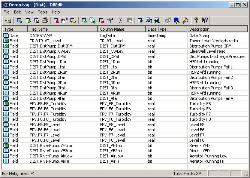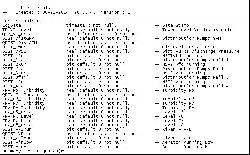
DBEdit provides a user friendly point and click interface allowing tables to be defined for
storing process and historical data. The tasks associated with creating tables, modifying
table structures, inserting data, and purging obsolete records is completely automated
allowing even the novice of user to create and maintain powerful repositories of
process information.
storing process and historical data. The tasks associated with creating tables, modifying
table structures, inserting data, and purging obsolete records is completely automated
allowing even the novice of user to create and maintain powerful repositories of
process information.
Click Image for a Larger View
An empty database and Data Source Name (DSN) are initially created with the desired
database vendor's tools and the Microsoft ODBC Administrator.
A table is defined by assigning a name and entering properties for the update interval,
DSN, and the number of days of history to maintain.
Next, columns are added by selecting the project's tags using a point and click browser
interface. During tag selection, a columns may be optionally defined containing the tag's
OPC quality.
Last, the Create Table, Structured Query Language (SQL) file is generated. This file is
executed in the selected database vendor's tools to physically create the table.
Once the table is defined and created, CPUtilities will begin inserting the process data
based on the defined interval. The system will maintain the configured "number of days
of history" by purging the oldest data in the table as required.
database vendor's tools and the Microsoft ODBC Administrator.
A table is defined by assigning a name and entering properties for the update interval,
DSN, and the number of days of history to maintain.
Next, columns are added by selecting the project's tags using a point and click browser
interface. During tag selection, a columns may be optionally defined containing the tag's
OPC quality.
Last, the Create Table, Structured Query Language (SQL) file is generated. This file is
executed in the selected database vendor's tools to physically create the table.
Once the table is defined and created, CPUtilities will begin inserting the process data
based on the defined interval. The system will maintain the configured "number of days
of history" by purging the oldest data in the table as required.
Click Image for a Larger View
Another advanced feature of the Database Editor is the ease of maintaining existing
tables. DBEdit maintains the version of each defined table. When changes to a project
are made, DBEdit compares the current state of each project table to the last version.
When differences are detected, an Alter Table SQL file is generated to bring the table up
to date. As with Create Table SQL, this file is executed in the database vendor's tools to
update the structure of an existing table.
Although DBEdit and other CPUtilities applications depend heavily on SQL, no
knowledge of SQL programming is necessary to implement the database. DBEdit does
require a minimal SQL syntax configuration to handle different vendor's
implementations, but provides default settings for the most popular offerings.
tables. DBEdit maintains the version of each defined table. When changes to a project
are made, DBEdit compares the current state of each project table to the last version.
When differences are detected, an Alter Table SQL file is generated to bring the table up
to date. As with Create Table SQL, this file is executed in the database vendor's tools to
update the structure of an existing table.
Although DBEdit and other CPUtilities applications depend heavily on SQL, no
knowledge of SQL programming is necessary to implement the database. DBEdit does
require a minimal SQL syntax configuration to handle different vendor's
implementations, but provides default settings for the most popular offerings.
DBEdit


